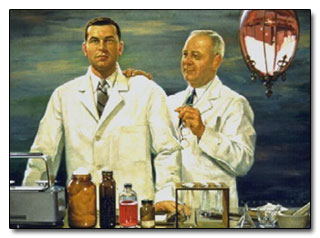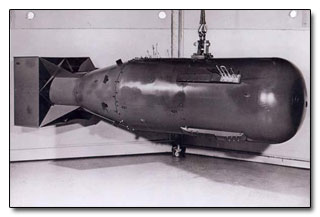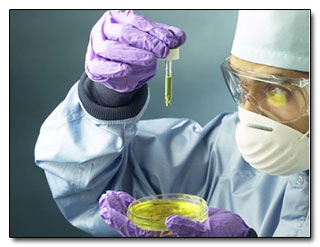5 Accidental Inventions That Changed The World

Sometimes it's better to be lucky than good.
Just ask the inventors of these products, each one having changed the way we live, and each one having come about either by serendipity or complete fuck-up. We're talking about...
The Microwave Oven

The microwave oven, aka the "Popcorn and Hot Pockets Warmer," was a happy accident that came from, of all things, a weapons program.
Percy LeBaron Spencer was a self-educated engineer working on radar technology in the years following WWII. The technology in question was the sci-fi sounding magnetron, a piece of machinery capable of firing high intensity beams of radiation.

Above: a scientist, with robot.
Apparently, P.L.S., as some have called him, had a bit of a sweet tooth. Or a strange fetish. Either way, he had a candy bar in his pants while he was in the lab one day. The self-proclaimed engineer noticed that the chocolate bar had melted when he was working with the magnetron.
Spencer disregarded the simple idea that his body heat had melted the chocolate in favor of the less logical and therefore more scientific conclusion that invisible rays of radiation had "cooked it" somehow.

A sane man would stop at this point and realize these magical heat rays were landing just inches from his tender scrotum. Indeed, most of the military experts on hand probably dreamed of the battlefield applications of their new Dick-Melting Ray. But like all men of science, Spencer was fascinated and treated his discovery like a novelty. He used it to make eggs explode and pop kernels of corn ("Imagine, a future where a building full of workers in cubicles eat this all day!")

I proclaim myself to be awesome.
Spencer continued to experiment with the magnetron until he boxed it in and marketed it as a new way to cook food. The initial version of the microwave was roughly six feet tall, weighed in around 750 pounds and had to be cooled with water. But they got it down to size, and today we use it mostly to destroy random objects on YouTube.
Krazy Glue and/or Super Glue

The story goes that in 1942, Dr. Harry Coover was working for Eastman Kodak, a company renowned for cameras and camera-related things. His job was to find a plastic that could be used as a clear gunsight, since this was smack in the middle of WWII and everybody knew where the money was.
Coover got frustrated because the material, called cyanoacrylate, was just too damned sticky. Rather than noticing he accidentally made one of the most versatile adhesives of all time, he threw it away in a huff and continued sweating over gunsights for a war that would be ended, ironically, by two bombs with blast radiuses so big that they didn't even require sights at all.

Aim optional.
Years later, Coover would re-discover his invention, we prefer to think due to him noticing that old container of cyanoacrylate was still stuck to the bottom of his trash can and couldn't be removed by any means.
In 1958, after finally convincing his bosses that at the very least, there was enormous comedic potential in the prospect of a man getting his hand permanently stuck to his junk; Kodak released the glue with the catchy name "Eastman 910."
Somebody then decided to actually pay the marketing guys to do something, and they decided the best way to convince people to buy this new product was to suspend a car over a public street with a crane, supposedly held up only with the ol' 910.

Reactions resulted in the product being coined "Krazy Glue"; a product so crazy that it requires intentional misspelling. The early slogan, "Remember, you can only use it once before it completely solidifies in the tube!" was quickly dropped and it remains a top-selling product to this day.
Vulcanized Rubber

You probably won't be shocked to find out that the inventor of tire rubber is Charles Goodyear, as he's the first guy on the list to actually get his name attached to the end product (since "Coover Glue" sounds like a gruesome form of birth control).
It wasn't easy coming up with a form of rubber tough enough to withstand the drag racing and car chases everyone envisioned the day the automobile was invented. In fact, if there was one man who should have given up his life dream, it was Goodyear. The man spent time in and out of prison, lost every friend he had and starved his children in his tireless pursuit of a stronger form of rubber.

"There's got to be a better way."
It was the 1830s, a period of time known for sucking. After his first two years of tinkering and failing with primitive rubber, Goodyear and his family were camping out in an abandoned factory and fishing for sustenance. This is when he made a huge breakthrough: He'd use acid to smooth out and toughen rubber! The government bought 150 mailbags made of the stuff and the rest is...
Oh, wait. They were all defective. The process didn't work and Goodyear was ruined. Again.

Finally in 1839, probably after being struck by lightning and/or being pissed on by a pack of stray dogs, Goodyear wandered into a general store with another failure of a formula. The crowd watched. Then they laughed at him. In a rage, he began to shake his fist, flinging a piece of his rubber onto the hot stove top.
After inspecting the charred remains, he realized that he had just found a way to make durable, weatherproof rubber. Despite what we're sure were numerous failed "now let's try setting this on fire to see if it improves it!" experiments, an empire was born.
Safety Glass

Safety glass is the glass that's used in cars and buildings and almost everywhere you look. The idea is that when it shatters, like when a bad guy goes through it back-first because you blasted him with a shotgun, it doesn't break into shards that can cut his skin on the way through. Frenchman, Edward Benedictus, was a jack-of-all-trades, er, Jaques-of-all-trades. Before stumbling across an incredible invention, Benedictus was already a classical quadruple threat. That is to say he was a painter, composer, writer and chemist.
One day, in a potentially Clouseau-like manner, Edward knocked a scientific flask off of a shelf and heard it crash to the ground (we like to imagine that he shouted "sacre bleu!" upon hearing the impact). When Benedictus climbed down from his ladder, he noticed that the flask was broken, but had not actually shattered.

After asking one of his aides about the incident, he found that the flask had recently contained cellulose nitrate, which acted as an adhesive and held the shattered pieces of glass together.

Artist's rendering of cellulose nitrate.
Though he knew he had something, Benedictus didn't really know what he had. Then inspiration struck in the form of a rash of horrifyingly gruesome car accidents. Benedictus noticed that the more horrific injuries from these crashes were due to flying shards of windshield.
Then he set to work until he eventually developed Triplex (not pronounced triple x). When we say eventually, we mean 24 hours later. After taking notice of the durability of his new invention in the gas masks of WWI, the automotive industry began making the Triplex windshield the standard, as angry, sledgehammer-wielding ex-girlfriends the world over can attest to.
Penicillin

As researchers go, Sir Alexander Fleming is one of the greats. But the man was a slob. Years before he became famous for discovering Penicillin, he accidentally conducted a study based around some snot of his that fell into a Petri dish.

Six years later, the good Mr. Phlegm-ing, as he was affectionately known, was once again working in the lab with a plastic dish filled with disease. The Doc (another nickname) left the lab for a weekend without cleaning the filthy dishes that were scattered around. If the scientific community is represented by the cast from Revenge of the Nerds (we know, huge stretch), then Fleming is "Booger"?

But in a lab coat.
Fleming returned to his abandoned experiment after his holiday to find that the dishes had sprouted mold. Fleming tossed the dish into a nearby trashcan. As per his custom, he continued to inspect his experiment after throwing it into a container filled with lab waste. Maybe he had decided to eat that sausage he had thrown away earlier.
While there he noticed that the mold had killed off the bacteria around it. This mold turned out to be the basic form of Penicillin, arguably the most important discovery in the field of medicine ever. All science needed was for a man to come along who was so filthy that he actually would discover a form of filth that could kill other filth. Millions of lives were saved.
Now check out how today's science is trying to destroy us, in The 5 Scientific Experiments Most Likely to End the World and 5 Recent Scientific Advances (And How They'll Destroy Us All).
And visit Cracked.com's Top Picks to see what accident lead to our rise to prominence (hint: it involves discovering boobs).